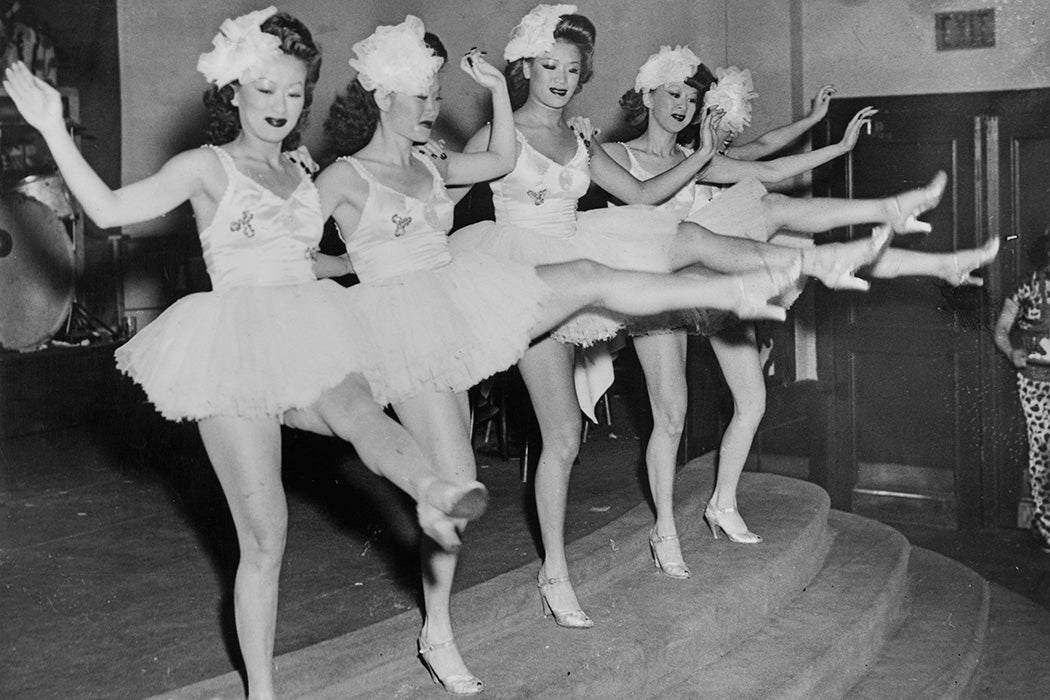Many fans of early cabaret and vaudeville are familiar with the “chitlin’ circuit,” the performance tours by Black performers for Black audiences. But Black performing artists weren’t alone in their cross-country venue hopping. Asian American performers of the 1930s and ’40s often traveled the “chop suey” circuit.
As theater scholar SanSan Kwan explains, “these Asian American entertainers headlined at so-called ‘Oriental’ night clubs such as the Forbidden City in San Francisco (which remained open until 1962) and the China Doll in New York.” Like their chitlin’ circuit counterparts, these musicians, dancers, and comedians found themselves crisscrossing the map, leaping from city to city—Seattle to St. Louis, Chicago to Corpus Christi, and back again. Some, like dance duo Dorothy Takahashi Toy and Paul Wing, even found themselves touring abroad and making cameos in big Hollywood films. But unlike the Black performers who primarily performed for Black audiences, Asian American found themselves in front of white audiences.
These performers walked a delicate line—both challenging and solidifying racial boundaries. As Kwan writes, their “exotic bodies allowed them entry because they were seen as novelties, as temporary sojourners, nonthreatening to the racial cartography because they were simultaneously recognizable and foreign.” They were allowed into these all-white spaces, but only because of their differences. And the audiences demanded that these differences be put on display.
Kwan notes that the performers “succeeded at ‘playing Oriental,’ performing acts like the ‘Fan Dance,’ the ‘Chinese Sleeve Dance,’ and the ‘Coolie Dance,’ in order to give Americans a look at exactly what they expected the ‘Asiatic’ to be.”
But they also performed in styles that audiences considered “All-American.” Toy and Wing often found themselves billed as “Chinese Fred and Ginger,” for example (though Toy was of Japanese descent), and others added popular songs to their setlists. Some even donned blackface (and whiteface) to perform as “Chinese Sammie Davis” or “Chinese Frank Sinatra.” But as Kwan points out, race and vaudeville were complicated companions. Beginning in the nineteenth century, “Irish Americans played blackface, Asian Americans played whiteface, African Americans played yellowface,” and each of these, in their distortions, “helped to solidify whiteness as the norm.”
By the 1930s, the cabaret scene had replaced vaudeville as “fashionable restaurants and hotels offered social spaces where the wealthy could flaunt their money.” These spaces needed entertainment and found that “exotic” performances were where the money was—Latin, Caribbean, and “Oriental” nights were the order of the day.
A 1946 review of Forbidden City praised its show, which included a mix of boogie-woogie and ballroom dancers, a juggling act, and singer Larry Ching, who crooned “Irish Lullaby” and “As Time Goes By.”
“The shows were very much American cabaret with a few superficial ‘Oriental’ touches,” Kwan writes.
The China Doll featured actor Jack Soo, who would go on to co-star in Flower Drum Song and Barney Miller, as its emcee. Shows were built around dancers doing the dances of the day—the rumba, waltz, cha-cha, and tango—and many of the house bands were notables in the Latin big band scene. For instance, legendary drummer (timbalero) Tito Puente was in the China Doll’s house band. Acts included comedians, nude dancers, and acrobats. Many of the clubs also showcased collaborations between Asian and non-Asian performers, including “comedienne Martha Raye, the Benny Goodman orchestra, or Chico Marx of the Marx Brothers.”
When touring the circuit, the carefully drawn lines of segregation became blurry. As Kwan notes that “in Jim Crow America, [B]lack and white territories were clearly marked, but space for Asian Americans was uncertain.”
Weekly Newsletter
Musician Helen Wong Jean noted that they generally stayed in white-only hotels, but there was always a perception of their otherness. “Chop Suey Circuit performers were necessarily defined by their foreignness,” confirms Kwan. Acceptance wasn’t a given and was always tenuous, relying on the circuit performers’ ability to be both relatable and exotic.
“They tap danced to ‘A Tisket, A Tasket’ in order to claim cultural citizenship, but they wore coolie hats to be comprehensible,” Kwan concludes. “[T]hey gained some small purchase, some access, not, paradoxically, by performing belonging but by revealing the difference underneath their whiteface.”
Support JSTOR Daily! Join our membership program on Patreon today.







